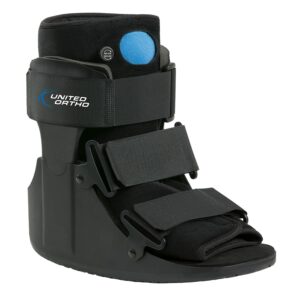Sprained Ankle
Last Updated on October 22, 2023 by The SportsMD Editors
What is an sprained ankle?
A sprained ankle is an injury to one or more ligaments in the ankle, usually on the outside of the ankle. Ligaments are bands of tissue that connect one bone to another and bind the joints together. In the ankle joint, ligaments provide stability by limiting side-to-side movement.
Ankle sprain grades
The severity of a sprained ankle depends on whether the ligament is stretched, partially torn, or completely torn, as well as on the number of ligaments involved. Physicians generally classify a sprained ankle based on its severity as a grade one, two, or three.
Grade 1 ankle sprain:
- Some stretching or perhaps minor tearing of the lateral ankle ligaments.
- Little or no joint instability.
- Mild pain.
- There may be mild swelling around the bone on the outside of the ankle.
- Some joint stiffness or difficulty walking or running.
Grade 2 ankle sprain:
- Moderate tearing of the ligament fibers.
- Some instability of the joint.
- Moderate to severe pain and difficulty walking.
- Swelling and stiffness in the ankle joint.
- Minor bruising may be evident.
Grade 3 ankle sprain:
- Total rupture of a ligament.
- Gross instability of the joint.
- Severe pain initially followed later by no pain.
- Severe swelling.
- Usually extensive bruising.
Other signs of a more extensive injury include tenderness along the bone, either on the inside or outside, as well as swelling and bruising along the inside of the ankle.
I have heard of professional athletes recovering from so called “high ankle sprains”. What’s the difference?
A high ankle sprain, also known as a syndesmotic ankle sprain, is a sprain of the syndesmotic ligaments that connect the tibia and fibula on the lower leg. Syndesmotic ankle sprains are known as high because their location on the lower leg is above the ankle. Unlike common ankle sprains when ligaments around the ankle are torn or receive injury through an inward twisting, high ankle sprains are caused when the lower leg and foot twist out. The biggest difference between the two injuries is that whereas athletes can predictably return to sport in 4-6 weeks after a standard sprained ankle, it can take much longer to return after high ankle sprains-as long as 6 months.. Additionally, in cases of unstable high ankle sprains, surgery is usually needed. In order to rule out a high ankle sprain and/or an associated fracture your physician may order a series of tests including an xray, CT scan, or MRI.
syndesmotic ligaments that connect the tibia and fibula on the lower leg. Syndesmotic ankle sprains are known as high because their location on the lower leg is above the ankle. Unlike common ankle sprains when ligaments around the ankle are torn or receive injury through an inward twisting, high ankle sprains are caused when the lower leg and foot twist out. The biggest difference between the two injuries is that whereas athletes can predictably return to sport in 4-6 weeks after a standard sprained ankle, it can take much longer to return after high ankle sprains-as long as 6 months.. Additionally, in cases of unstable high ankle sprains, surgery is usually needed. In order to rule out a high ankle sprain and/or an associated fracture your physician may order a series of tests including an xray, CT scan, or MRI.
Ankle sprain symptoms:
- Pain or soreness
- Swelling
- Bruising
- Difficulty walking
- Stiffness in the joint
These symptoms may vary in intensity, depending on the severity of the sprain. Sometimes pain and swelling are absent in people with previous ankle sprains—instead, they may simply feel the ankle is wobbly and unsteady when they walk. Even if you don’t have pain or swelling with a sprained ankle, treatment is crucial.
What causes a sprained ankle?
The most frequently seen sprain occurs when weight is applied to a foot that is on an uneven surface, and the foot rolls over on the outside. Because the sole of the foot is pointing inward as force is applied, the ligaments stabilizing the lateral – or outside – part of the ankle are stressed. A sprained ankle commonly occurs while participating in sports, wearing inappropriate shoes, or walking or running on an uneven surface. There are a number of factors that predispose an individual to a sprained ankle. These include:
1) Minimal rehabilitation of a previously sprained ankle
2) Poor joint proprioception (proprioception is the ability to sense where a joint is …. if you don’t know where your ankle is, the muscles will not be able to prevent the ankle sprain)
3) Generalized ligament laxity (some individuals have loose joints so to speak and can roll over their ankles very easily.
4) Weak muscles (they are just not strong enough to prevent the sprain occurring)
Ankle sprain treatment. What to do?
Any sprained ankle—whether it’s your first or your fifth—requires prompt medical attention. The sooner treatment starts, the greater the chance to prevent chronic pain and long term instability. Many of the problems resulting from sprains are due to blood and edema in and around the ankle. Minimizing swelling helps the ankle heal faster. Sports injury treatment using the P.R.I.C.E. principle Protection, Rest, Icing, Compression, Elevation facilitates this and should be initiated ASAP even before a physician is seen:
Protection– The first principle is protection. The purpose of protection is to avoid further injury to the ankle by protecting the injured structures. The type of protection used varies but may include an ace bandage, protective tape, or over-the-counter brace.
Rest–You may need to rest your ankle, either completely or partly, depending on how serious your sprain is. Use crutches for as long as it hurts you to stand on your foot.
Ice–Using ice packs, ice slush baths or ice massages can decrease the swelling, pain, and bruising and muscle spasms. Keep using ice for up to 3 days after the injury.
Compression–Wrapping your ankle may be the best way to avoid swelling and bruising. You’ll probably need to keep your ankle wrapped for 1 or 2 days after the injury and perhaps for up to a week or more.
Elevation–Raising your ankle to or above the level of your heart will help prevent the swelling from getting worse and will help reduce bruising. Try to keep your ankle elevated for about 2 to 3 hours a day if possible.
Prompt medical attention is crucial because an untreated sprained ankle may lead to chronic ankle instability, a condition marked by persistent discomfort and a “giving way” of the ankle. You may also develop weakness in the leg. In addition, you may have suffered a more severe ankle injury like an ankle fracture along with the sprain. This might include a serious bone fracture that could lead to troubling complications if it goes untreated. Lastly, rehabilitation of a sprained ankle needs to begin right away. If rehabilitation is delayed, the injury may be less likely to heal properly.
Ankle sprain KT Tape
Ankle sprain KT Tape can be used for a sprained ankle and the added support will help during the rehabilitation phase of an injury as well as the stability and pain relief during activity.
Ankle sprain boot
A comfortable ankle sprain boot can help with walking and can easy the pain caused by ankle sprains. An ankle sprain boot helps immobilize and protect the injured area from further damage to the ligaments and aids in the healing process.
Here is an ankle sprain boot to consider:
United Ortho Short Air Cam Walker Fracture Boot
- This Cam Walker Boot can be used for acute ankle sprains, soft tissue injuries,

ankle sprain boot stable lower leg, foot and ankle fractures and post-operative use.
- Promotes natural walking with rocker sole and shock-absorbing insole promote more natural walking during use.
- Sturdy plastic molded uprights with steel reinforcement provides increased durability.
Ankle sprain surgery
Except for specific instances of associated fractures and/or unstable high ankle sprains, the overwhelming majority of ankle sprains are treated with conservative measures. It is important to begin treatment immediately to ensure a good outcome.
In addition to the P.R.I.C.E. principle, your doctor may prescribe you a walking boot or even a cast for a short period to immobilize the ankle. Anti-inflammatory medication may also be used to help. Once the acute phase of pain and swelling has subsided then a course of physical therapy will be initiated. The rehabilitation exercises are the most important aspect of recovering full function of the ankle. These will consist of exercises to increase proprioception, ankle braces and strapping to facilitate activity, muscle strengthening and flexibility exercises, gradual return to any sporting activities, and the long term goal of maintaining fitness by doing alternative activities to prevent any recurrence.
Get a Telehealth Appointment or Second Opinion With a World-Renowned Orthopedic Doctor
 Telehealth appointments or Second Opinions with a top orthopedic doctor is a way to learn about what’s causing your pain and getting a treatment plan. SportsMD’s Telehealth and Second Opinion Service gives you the same level of orthopedic care provided to top professional athletes! All from the comfort of your home.. Learn more via SportsMD’s Telemedicine and Second Opinion Service.
Telehealth appointments or Second Opinions with a top orthopedic doctor is a way to learn about what’s causing your pain and getting a treatment plan. SportsMD’s Telehealth and Second Opinion Service gives you the same level of orthopedic care provided to top professional athletes! All from the comfort of your home.. Learn more via SportsMD’s Telemedicine and Second Opinion Service.
Ankle sprain recovery time
- Most people can resume their activities of daily living within 5 to 7 days provided appropriate treatment has been initiated.
- For most simple ankle sprains, athletes typically can return to play at approximately 3-6 weeks.
- During this initial period of return to play, you can help prevent further sprains and setbacks by wearing a semi-rigid ankle brace when you exercise for another 1 to 2 months. Special wraps that use hook and loop fasteners, or air-filled or laced braces may also help prevent reinjury. Wearing high-top tennis shoes may also help prevent a sprained ankle if your shoes are laced snugly and if you also tape your ankle with a wide, nonelastic adhesive tape. Elastic tape or braces are usually not helpful because the elastic gives too much around the joint.
Ankle sprain exercises
Once your sprain has completely healed, a program of ankle exercises will also help prevent reinjury by making the muscles stronger, which provides protection to the ligaments. The exercises may be prescribed by your physical therapist or trainer:
Ankle Circles
Sit on the floor with your legs stretched out in front of you. Move your ankle from side to side, up and down, and around in circles. Do 5 to 10 circles in each direction at least 3 times per day.
Toe Raises
Pull your toes back toward you while keeping your knee as straight as you can. Hold for 15 seconds. Do this 10 times.
Heel Raises
Point your toes away from you while keeping your knee as straight as you can. Hold for 15 seconds. Do this 10 times.
In and Out
Turn your foot inward until you can’t turn it anymore and hold for 15 seconds. Straighten your leg again. Turn it outward until you can’t turn it anymore and hold for 15 seconds. Do this 10 times in both directions.
Resisted In and Out
Sit on a chair with your leg straight in front of you. Tie a large elastic exercise band together at one end to make a knot. Wrap the end of the band around the chair leg and the other end around the bottom of your injured foot. Keep your heel on the ground and slide your foot outward and hold for 10 seconds. Put your foot in front of you again. Slide your foot inward and hold for 10 seconds. Repeat at least 10 times each direction 2 or 3 times per day.
Step Up
Put your injured foot on the first step of a staircase and your uninjured foot on the ground. Slowly straighten the knee of your injured leg while lifting your injured foot off the ground. Slowly put your injured foot back on the ground. Do this 3 to 5 times at least 3 times per day.
Sitting and Standing Heel Raises
Sit in a chair with your injured foot on the ground. Slowly raise the heel of your injured foot while keeping your toes on the ground. Return the heel to the floor. Repeat 10 times at least 2 or 3 times per day. As you get stronger, you can stand on your injured foot instead of sitting in a chair and raise the heel. Your injured foot should always stay on the ground.
Balance Exercises
Stand and place a chair next to your uninjured leg to balance you. At first, stand on the injured foot for 30 seconds. You can slowly increase this to up to 3 minutes at a time. Repeat at least 3 times a day. To increase the difficulty, repeat with your eyes closed.
References
McKeon PO, Mattacola CG. Interventions for the prevention of first time and recurrent ankle sprains. Clin Sports Med 2008. 27(3): 371-382.
Jelinek JA, Porter DA. Management of unstable ankle fractures and syndesmosis injuries in athletes 2009. 14(2) 277-298.


